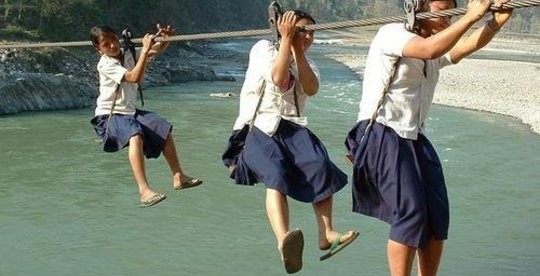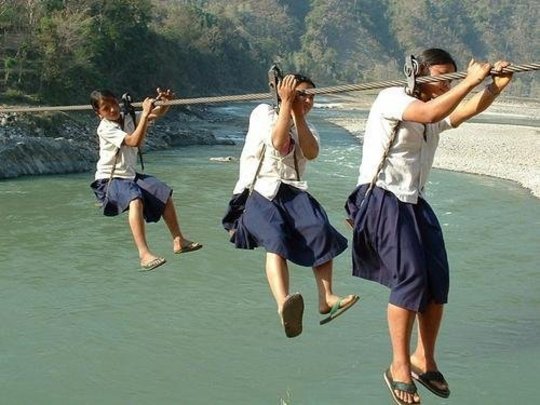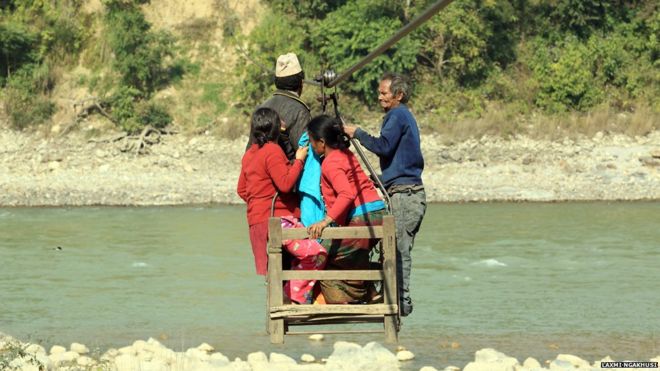The High-Wire Act Some Nepalese Children Take to School


The image above has been making its way around the Internet for years. (Here’s a Google Images search for it; you’ll see hundreds of examples.) The source of the photo has therefore been effectively lost, and what the photo is therefore a picture of is hard to state with certainty. The collective wisdom, though, suggests that the picture is of three girls in Nepal, crossing a river to get to their school — and there’s good reason to believe that the collective wisdom is correct. Here’s a picture, via the BBC, of something in Nepal which is similar — and similarly scary:

The Trishuli River, which runs through central Nepal, is one of the reasons for the contraption. Wikipedia describes the river’s value for those who want to engage in water sports, noting that it is a “popular rafting river with impressive gorges, exciting rapids, some easier sections and easy accessibility from Kathmandu and Pokhara,” Nepal’s two largest cities.
But what’s good for adventurers hailing from larger cities can be treacherous for villagers who just want to get to a nearby community. For example, if a child wants to go to school but her classroom is on the other shore of the Trishuli, she needs to cross it. And that’s difficult. As explained in this video by the Museum of Science, Boston, the river is difficult to cross on foot in even the best of conditions, often requiring an adult to carry children through the water. In rainy weather — and from June through August, that’s close to an everyday occurrence — the rivers are impassable by foot. Bridges are expensive and hard to maintain, and therefore rare. Many Nepalese villagers are isolated for weeks at a time.
One solution solution is a “tarpul” or WireBridge, seen above. It is the brainchild of a non-profit organization named VillageTech Solutions (who used the above photo as part of a fundraising campaign a few years ago to showcase their product). Per VillageTech’s website, the organization saw the “struggle for basic facilities such as education, electricity, transportation and potable drinking water,” and wanted to act. It now develops “affordable and relevant technology solutions that are easily adopted and operated by these communities.”
The WireBridge is one of those products — wires connected by poles, to which a harness or gondola is attached for the trip across. Over time, other organizations have built similar bridges, and it’s hard to measure how many people avail themselves of this mode of transportation — accurate records are understandably hard to come by. But according to an organization called Bridges to Prosperity, a bridge which spans a tributary of the Trishuli carries about 200 travelers each day, while a second bridge — this one over a seasonal river created by monsoons — provides transport for another 120 people daily as needed.
The risks to life and limb from using one of these is very real; the above-linked BBC discusses on tragic accident which cost five people their lives and some other near-misses. But the alternative means isolation, and therefore limited access to education, health services, and trading opportunities. As a result, the WireBridges have become an important part of the lives of many in rural Nepal.
 Bonus Fact: Nepal’s flag — seen here — is the world’s only national flag that isn’t a quadrilateral. This makes it hard to draw — you can’t just be given an aspect ration — but don’t worry, as it’s easy to find a how-to guide. The Nepalese Constitution (via Wikipedia) has detailed instructions included in the document.
Bonus Fact: Nepal’s flag — seen here — is the world’s only national flag that isn’t a quadrilateral. This makes it hard to draw — you can’t just be given an aspect ration — but don’t worry, as it’s easy to find a how-to guide. The Nepalese Constitution (via Wikipedia) has detailed instructions included in the document.
From the Archives: A Bag Over Troubled Water: The crazy way some kids in Vietnam make their way to school.
Take the Quiz: How much do you know about Nepal?
Related: “On the Way to School,” a documentary which follows a few kids on their way to school. It’s not about school buses. Some cross rivers on horseback, others are pushed by their younger siblings on wheelchairs, some hitchhike, and two have to avoid lions.
